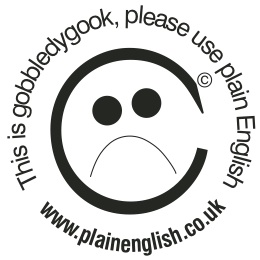Plain English Campaign gets it wrong

In almost all cases, I support the Plain English Campaign, who aim to improve the readability of government documents, corporate letters, web sites, and other forms of communication.
In their 2011 Golden Bull Awards, however, the Plain English Campaign got it dead wrong.
The UK Met Office won an award for ‘empowering people to make their own decisions’ by using the technical systems for the ‘probabilities of precipitation’. Presumably, the Campaign was upset that terms such as “very likely” are replaced by something like “70% chance of rain”. This award was picked up by the UK newspapers like the Metro, Daily Mail, and Guardian. Apparently, one of the issues is that the forecasts now have an “American style” to them.
Here is the Met Office explanation for why probabilities were introduced. Specifically,
Often people want to make a decision, such as whether to put out their washing to dry, and would like us to give a simple yes or no. However, this is often a simplification of the complexities of the forecast and may not be accurate. By giving PoP we give a more honest opinion of the risk and allow you to make a decision depending on how much it matters to you. For example, if you are just hanging out your sheets that you need next week you might take the risk at 40% probability of precipitation, whereas if you are drying your best shirt that you need for an important dinner this evening then you might not hang it out at more than 10% probability. PoP allows you to make the decisions that matter to you.
Let’s face it. As good as meteorologists do with the forecasts, there is still a measure of uncertainty, even for forecasts less than a day in advance. I would like to think that communicating the uncertainty to the forecast is something that the public would appreciate, but perhaps numerical values are too much. If the American public can interpret that a 70% chance of rain is larger than a 50% chance of rain, I don’t understand why the British can’t.



Getting forecasters to be specific is a step in the right direction. As it is, they are sometimes vague and non-committal, shrouding their forecasts in a strange folksy backchat. In some of the numerical forecasts, however, you’re not given a single a number but a range – say between 20% and 40%. Thus, you don’t just have to assess the odds of its raining, but you have to make your own judgement on how right the forecasters are.
Hi Paul,
I agree with the examples from your web site. Being more clear and precise is something that broadcast meteorologists could improve upon. I’m not sure how that language evolved, but it certainly isn’t precise.
I don’t know the specific instances where forecasters offer a range of probabilities, but it may be that they are trying to describe the spatial variation in likelihood of rain (20% to the south to 40% in the north). Possibly. I can’t say for sure.
Thanks for your comments.
Forecasters be warned! Be precise where possible!
Dave